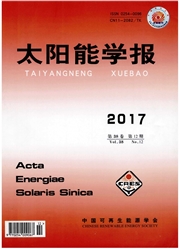

 中文摘要:
中文摘要:
提出一种利用电容测量生物质灰渣熔融状态的方法,以低熔点的玉米芯灰为样品进行测试,并与X射线荧光分析(XRF)、X射线衍射分析(XRD)、热重-差热分析(TG-DSC)结果进行比较.实验结果表明:玉米芯灰样在600-1000℃加热过程中质量的减少主要由灰分中KCl随加热过程挥发所致,并影响灰熔融温度预测结果;灰样烧结温度为800-900℃,电容测试结果为825℃,TG-DSC测试结果为875℃,灰熔点仪测试结果为990℃.电容测量结果与灰样熔融结渣情况一致,电容变化可准确反映灰样相变情况.与常规灰熔点测试和热重分析相比,该方法可实现实时监控测量,并减小测试过程中碱金属元素受热挥发造成的误差.
 英文摘要:
英文摘要:
A novel method for biomass ash melting measurement with electric capacitance was proposed. The melting process of corncob ash with relatively low melting point was investigated, and the measuring result was compared with that determined by X-ray fluorescence analysis (XRF) , X-ray diffraction analysis (XRI)) and thermogravimetric- differential scanning calorimeter (TG-DSC). The results show that the ash mass decreases while heated under 600-1000 ℃ due to the volatilization of KC1, which would influence the estimation of ash fusion temperature. The corncob ash melting temperature ranging from 800 ℃ to 900 ℃ was measured to be 825 ℃ by this method, 875 ℃ by TG-DSC, and 990 ℃ by ash melting point apparatus, respectively. Having the same changing tendency with the ash melting process, the variation of electric capacitance could accurately reflect the phase change of ash. Compared with common melting point measurement and TG-DSC, this method can be used for real-time monitoring with less errors caused by volatilization of alkali metals.
 同期刊论文项目
同期刊论文项目
 同项目期刊论文
同项目期刊论文
 期刊信息
期刊信息
